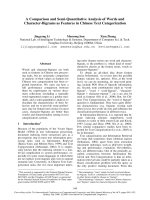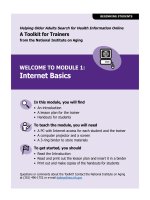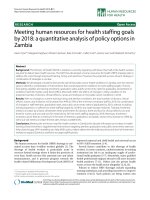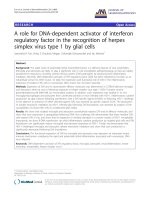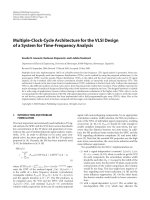The Commons A Toolkit for the Quantitative Analysis of Factors in the Success or Failure of Electronic Societies
Bạn đang xem bản rút gọn của tài liệu. Xem và tải ngay bản đầy đủ của tài liệu tại đây (255.9 KB, 9 trang )
The Commons: A Toolkit for the Quantitative Analysis of
Factors in the Success or Failure of Electronic Societies
Joshua Berman
Microsoft Research
Microsoft Corporation
One Microsoft Way
Redmond, WA 98052 USA
+1 404 786 1698
Steven M. Drucker
Peter Kollock
Microsoft Research
Department of Sociology
Microsoft Corporation University of California at Los Angeles
One Microsoft Way
Los Angeles, CA 90095-1551
Redmond, WA 98052 USA
USA
+1 425 703 5880
+1 310 825 1313
ABSTRACT
In this paper, we introduce The Commons, which is a
novel methodology and toolkit to aid in the design and
study of online societies. We first discuss the foundations
which led to its inception, and explain the design
decisions made along the way to its completion. Next, we
describe the system itself. We then describe and analyze
the results of a user study, which shows that this
methodology is valid, and that the toolkit produces results
comparable to the existing social science literature. In this
study we examine a particular form of online
communication -- synchronous text chat - and report on
its effects in increasing trust and cooperation in online
interactions. It is a common intuition that communication
leads to more cooperative online relationships but
intuition is not proof, nor does intuition provide a precise
mapping of the effects and dynamics of various forms of
communication on cooperation. Next, we will examine
the usefulness of The Commons in the design of
successful electronic societies by exploring its advantages
over those methods most commonly used today. Finally,
we discuss the importance of this platform for continued
experimental research in both the social science and
computer-human interaction research communities.
Keywords
Electronic Societies, Virtual Communities, Social
Interfaces, Social Computing, Computer-Mediated
Communication,
Community
Computing,
Social
Dilemmas
INTRODUCTION
What does it mean for an electronic society to be
successful? Many researchers over the past two decades
have hypothesized about what it takes, but very few have
precisely defined what it means.
Some researchers have simply used 'community' as a
descriptive measure, so that a successful online society
would have more 'community'. Affordances and societal
choices which led to its success would be said to have
'built community'. However, this approach does not help
designers, developers or maintainers of electronic
societies. They ask how this measure can be compared
across different societies. They wonder how to tell
whether their work is increasing or decreasing this
abstract factor.
There has been some attempt to measure success in terms
of "retention factor"[4] -- a survival-of-the fittest
approach, where success can be measured by user count.
Of course, this means that the effect of new affordances
and societal changes can not be measured, and that
advertising and market pressure must guide even
researchers' view of how to create successful online
society.
Others have argued that that success can be measured in
terms of "village like-quality"[3] or how well they
"resemble 'real life' communities"[19]. This method begs
the question. What makes a successful village or
successful 'real life' community? It is the very fact that
these are questions that are applicable to non-electronic
societies which led to our solution to the problem. If the
same standards for success of society apply online and
offline, is there a metric for the success of societies in
general? Could this metric be quantified, and used to
study electronic societies specifically?
One such metric has already been developed. Across a
variety of disciplines in the social sciences, a key way of
conceptualizing and measuring the success of a
relationship or group is to look at the level of trust and
cooperation that exists. In fact, a well-defined set of
models and methods has been developed to test the
existence and dynamics of cooperation in social relations
[9,12,14].
We have created a system that capitalizes on these
methods to create a rich and extensible toolkit that can be
used to better understand and develop successful
electronic societies.
PREVIOUS AND RELATED WORK
The research area we draw upon from the social sciences
is the cross-disciplinary work on social dilemmas. Social
dilemmas are those situations in which an individually
reasonable decision leads to collective disaster, that is, a
situation in which everyone is worse off than they might
have been otherwise. Models of social dilemmas capture
this tension between individual and collective outcomes,
and can therefore be used as a very powerful and broadly
applicable probe to assess the level of cooperation and
trust in a group. Since the 1950s, a large research
literature has developed in this area (for reviews, see
[9,12,14]).
However, there has been surprisingly little current work
that has applied social dilemma models to online
interaction and electronic societies. A recent exception is
Rocca's work that examined the difference between
electronic and face-to-face communication [16]. In
Rocca's research, a specialized system was built, and a
specific experiment was run, to show the difference
between online and face-to-face communities. What we
have completed is instead a generalizable toolkit and
methodology capable of capturing not only these basic
differences, but differences created by interface or social
factors within electronic societies themselves. The toolkit
created, which we have named The Commons, allows and
facilitates the usage of social dilemma paradigms to study
electronic societies, as shown in Figure 1.
THE COMMONS
The Commons toolkit was created using the V-Worlds
Platform, a robust and extensible framework for
distributed persistent objects [18]. The V-Worlds system,
specifically designed to facilitate the development of
shared virtual environments, offered many advantages,
namely, automatic communication between multiple
clients, easy programming via scripting, convenient
interface prototyping via Dynamic HTML, and integration
with the World Wide Web.
The fact that the V-Worlds Platform was designed
specifically for the creation of shared virtual
environments aided in the development process. In
particular V-Worlds maintains the notion that multiple
clients can be connected to a virtual room and that all
clients automatically receive updates for any state
changes to objects occurring within the room. Hence,
much of the communication infrastructure was already
completed, and creating the specialized types of
communication for The Commons was often a matter of
just a few lines of code.
In addition, because of the modular nature of the
platform, and the ability to modify objects even at run
time, different behaviors could be easily prototyped. This
created the ability to quickly and easily modify an
existing environment to include The Commons, and to
change experimental conditions with little change to the
rest of the interface and user experience.
Also, V-Worlds was specifically designed to allow world
creation and modification in Active Scripting languages.
The Commons
Allows and facilitates
the use in electronic
societies of
The Social Dilemma Paradigms
Which allow the
quantification of
Levels of Trust and Cooperation
Present
Which is a historically
valid measure of
The Health and Success of a
Society
Figure 1. The Commons uses an existing body of
work in the social sciences to create a novel toolkit
and methodology for the design and analysis of
electronic societies.
This allowed us to create a toolkit which could be used
easily by members of the sociology, psychology and
design community without the need for dedicated
developers. For example, to change the reward payoff for
a social dilemma game, an experimenter must simply
change a single variable in a JavaScript textfile. No
knowledge of programming is required.
Finally, the V-Worlds architecture, integrated in design
and practice with Microsoft Internet Explorer, allowed us
to create tools which could be run on the World Wide
Web, allowing The Commons to run experiments
efficiently and inexpensively which were not previously
possible. Examples of these types of experiments would
be those done over a great geographical distance, an
extended period of time, or those wishing to use the large
user population of the World Wide Web. The potential
advantages of this platform for experimental research are
detailed at the end of this paper.
A set of interface elements, along with a related set of
internal states and methods, were added to the V-Worlds
system, to create a toolkit for the modeling of social
dilemmas. For our initial studies, we chose to focus on an
iterated Prisoner's Dilemma Game. The game is iterated
in that partners play it repeatedly with each other. This
allows relationship to build over the course of the
experiment, and effects to be recognizable which might
only occur over time. For our first study, we focus on the
dyadic (2-person) version of the game, although future
studies will examine the multiple person (termed NPerson) versions of the game as well. We also chose to
use a continuous version of the game: in the classic
Prisoner's Dilemma, subjects are given the dichotomous
choice of cooperating completely or defecting completely.
This is an unrealistic and restrictive assumption given that
interaction usually involves degrees of cooperation
[10,22]. For this reason, we permit a range of cooperation.
The rules of this game are given in figure 2.
At the beginning of each round, you will be
given 10 points. During each round you will
be asked to decide how many of the 10
points you want to give the person you are
interacting with. The amount you give
away will be DOUBLED and given to the
other person. However, YOU DO NOT
RECEIVE ANY RETURN FROM THE POINTS
YOU GIVE OUT.
The person you are interacting with is
asked to make exactly the same decision. If
s/he contributes some points, they will be
doubled and you will receive them.
Figure 2. Instructions for the iterated dyadic
continuous prisoner's dilemma.
Thus, the situation has the structure of a Prisoner's
Dilemma: The greatest possible return comes from
keeping all of one's points while one's partner contributes
all 10 points (a return of 30 points -- the 10 original
points plus the 20 points from the partner's doubled
contribution). However, if both actors follow this strategy
each will end up with only 10 points (having contributed
none to each other) rather than the 20 points each could
receive if each contributed all their points.
Although this game was chosen as an initial social
dilemma, other games can be easily modeled with the
same toolkit by making simple scripting changes.
However, this choice of a default dilemma model has
several benefits. As opposed to discrete dilemmas where
the only options available to players are to cooperate or
defect, the continuous nature of this game allows
experimenters to see more finely grained differences in
levels of cooperation. Also, the simplicity of the game, as
evidenced by the brevity of the instructions, allows the
games to be run quickly without prior user training.
Finally, the dyadic nature of the game allows experiments
to be run without the necessity of coordinating or
compensating large groups as in the polyadic cases. This
also means that experimenters can control for many
confounding variables present in group cases,
concentrating instead
on those
variables the
experimenters wish to study.
Using this game, a module was created for V-Worlds that
would provide all of the necessary affordances not only
for the play of the game, but for the recording of any data
that would be relevant to or of interest to the
experimenter. Again in this process every effort was made
to preserve the flexibility of the toolkit, allowing for
changes in data presentation and recording to be made
simply and easily in Active Scripting languages.
Once the general toolkit was created and tested, scripts
were created in order to test the validity of this approach
by running a simple but important experiment. Using the
Commons toolkit, we designed and implemented an
experiment to study the effects of communication on
levels of cooperation in online interactions.
Specifically, we examine a particular form of online
communication – synchronous text chat – and report on
its effects in increasing trust and cooperation in online
interactions. It is a common intuition that communication
leads to more cooperative online relationships –
electronic society designers and maintainers are well
aware that lack of communication ability can severely
undermine attempts to create a successful community
[1,20]. However, intuition is not proof, nor does intuition
provide a precise mapping of the effects and dynamics of
various forms of communication on cooperation. What is
called for is a series of experimental studies that
determine the effects of different kinds of information
flows and how those effects change across time and
across different interfaces. We begin this research agenda
here.
THE VALIDATION STUDY
Introduction
In this study, subjects played an iterated dyadic
continuous prisoner's dilemma for seventy rounds. They
did not meet each other face-to-face before, during, or
after the game. Approximately half of the subjects who
played were allowed to send text messages to each other
(chat) during the game. The other half had no
communication beyond what the game itself provided.
Data was gathered on the contribution made by each
player at each round, as well as data about chat message
counts and contents.
This data was then analyzed to determine whether there
was a significant difference in the level of trust and
cooperation between the two groups of subjects. Based on
the previously cited work in the creation of electronic
communities, we hypothesized that there would indeed
be such a difference, with the group able to chat having
the higher level of trust and cooperation. Therefore, we
were interested in showing that The Commons could
demonstrate this widely assumed fact to be true, and how
descriptive it would be of its effect.
Further, we used this experiment to check the validity of
the approach in general by comparing contribution rates
in the group without chat with other similar studies from
social dilemma research which were not performed
online.
Subjects
The subjects were 201 adults aged 26 to 54 years old
(average=41.05). Approximately half of the subjects were
men (n=12) and half of the subjects were women (n=8).
They were recruited from a non-employee Microsoft
subject pool, and only subjects with intermediate Internet
skills and some experience with Microsoft Internet
Explorer were selected to participate. In addition to the
compensation related to performance in this specific
experiment as will be discussed later, subjects received a
gratuity of one Microsoft software package of their choice
for participation.
Procedure
The subjects were randomly assigned to two groups. All
factors were held constant between the two groups with
the exception of the fact that one group (the chat
condition) was given instructions and affordances for
sending and receiving text messages with their partner
during the experiment.
Each participant, isolated from all other participants
throughout the experiment, was given a preliminary
briefing that their performance in the game would affect
their reward upon leaving. Informed consent was
gathered at this time. They were then given semi-random
three digit user numbers which were used as monikers for
the rest of the experiment to control for any effects real
names might have created.
Each participant then read a series of instructions using
HTML Web Pages. These instructions explained the rules
of the game and that it would continue for "approximately
100 rounds". In addition, these instructions were written
to reinforce that a subject's success in the game would
affect their compensation, and included a test of
understanding, which the subjects were required to
complete correctly before continuing.
Once both the subject and their partner had completed the
instructions and test of understanding, they began to play
the game using the interface shown in Figure 3.
During the game, each player's contributions, as well as
any chat interaction, was recorded for further study. Play
continued without interruption for 70 rounds, at which
time the game was ended without warning to avoid endgame effects [2]. Each participant then completed an
electronic questionnaire containing background and
impression data, as well as other measures of interest to
the experimenters. Next, each subject was interviewed
and asked open-ended questions about their experience.
Each was then given extra compensation in the form of
gift certificates based on their final score in the game,
thanked for their participation, and given their software
gratuity.
Results
Analysis of the post-experimental questionnaire provides
1
An additional pair of subjects were dropped from the
analyses when it became clear that they did not
understand the experimental instructions
Figure 3. Interface for the experiment. It has been
shrunk to fit the page. In the condition without chat,
the "Chat History" pane and input areas are not
present, but the rest of the interface remains the same.
evidence that the subjects were motivated to earn as
much as possible (mean = 5.50; seven point scale), rated
the instructions they received as very clear (mean = 6.89),
and enjoyed participating in the experiment (mean =
5.00).
None of these scores differed significantly
between the two experimental conditions.
At the conclusion of the experiment, the data was
analyzed for both group differences and trends with time.
Therefore there was more than one hypothesis being
tested. Due to the small sample size, it was assumed that
we would not reach levels of statistical certainty.
However, the results, as shown in figures 3 and 4, were
clearly compelling, and statistical analyses were
performed to determine whether the differences both
between and within conditions could be shown
significant. Statistics for pairs of participants were
averaged to account for the dependency between partners.
Descriptive statistics showed clear differences between
the groups, henceforth labeled as chat and no-chat. The
means were 8.10 for chat and 4.38 for no-chat. Medians
were 10 and 3.25 respectively. It was also noted that the
variance was much higher for the condition without chat,
17.14 as opposed to 8.84. Due to the small number of
participants, this difference approached, but did not reach,
signficance,
Effect of Chat on Average Contribution - By Blocks of Five Rounds
10
9
Average C on t rib ut ion
8
7
6
With Chat
5
Without Chat
4
3
2
1
0
1
2
3
4
5
6
7
8
9
10
11
12
13
14
Block of Five Rounds
Figure 4. Average contribution by participants in each condition, in blocks of five rounds each.
Difference in Average Contribution - By Blocks of Five Rounds
6
C h at M in us N oC h at
5
4
Difference in
Average
Contribution
3
2
1
0
1
2
3
4
5
6
7
8
9
10
11
12
13
14
Block of Five Rounds
Figure 5. The difference in average contribution between the two conditions, in blocks of five rounds each.
F(1,8)=3.00, p.12. However, using more appropriate
statistical approaches, several results could be shown to a
level of proof.
OTHER FINDINGS
Another key set of results comes from the postexperimental questionnaire. Subjects were presented
with the four possible extreme outcomes of the game
(mutual cooperation, mutual defection, exploitation of
partner, exploitation of self), and asked to rate the
desirability of each outcome on a 7-point scale.
These questions are one way of assessing the subject’s
subjective transformation [7] of the game, that is, the
subjective ranking that a person assigns to an outcome,
which may, of course, be different than the objective
payoff.2
Figure 6 displays the mean rating for the four outcomes
for each experimental condition. Note that in both
conditions, mutual cooperation is ranked more highly than
exploitation of partner, even though exploitation of
partner (I contribute nothing while my partner contributes
all 10 points) results in the greater number of points.
Note that subjects in the chat condition compared to the
no-chat condition are much more dissatisfied with an
outcome of mutual defection or an outcome of
successfully exploiting one’s partner. In other words, the
subjects in the chat condition have a greater
2
This method of assessing transformations follows [7]
and [20]. Subjects' answers to questionnaire items such
as these have been shown to be predictive of their actual
choice behavior in games involving money [20].
Desirability of Outcome
The data seemed to suggest that cooperation decreased
over time in the no-chat condition, while remaining stable
in the chat condition. To test this, repeated measures
anova tests were performed to test for the main effect of
blocks of rounds across time. For these tests, rounds were
considered in fourteen blocks of five. For the no chat
condition, round block had an effect of significance,
F(13,52) = 3.06, p<.01. For the chat condition, there was
no significant effect of round, F(13,52) = 1.06, p.41.
Combining these results with the graphs of figures 4 and
5 showed these hypotheses to be true.
Finally, although the overall between-subjects difference
was not strongly statistically significant, the interaction
effect between condition and round was. Precisely, the
effect of chat on cooperation rates as compared to that of
no-chat differ across the trials, with chat having an
increasing relative effect over time. Another way of
stating this is that the difference between the two
conditions increases over time, F(13,104) = 2.19, p<.02.
These results showed that The Commons was not only
able to show the difference in trust and cooperation which
communication provided, but was able to prove it to a
higher bar than was needed, namely statistical
significance.
7
6
Mutual Cooperation
5
4
3
Exploitation
of Partner
Mutual
Defection
2
Exploitation of Self
1
No Chat
Chat
Experimental Condition
Figure 6. Effect of chat on subjective preference
structure.
relative preference for mutual cooperation.
Finally, in the post-experimental questionnaire, the
subjects were also asked to evaluate their partner on 16
bipolar scales. 3
Interestingly, subjects in the chat
conditions rated their partner more favorably on all of
these dimensions.
A number of these differences
approach or reach statistical significance: Subjects in the
chat condition on average rated their partner as more
helpful than subjects in the no-chat condition (p = .002),
more flexible (p = .056), more rational (p = .068), and
more honest (p = .088).
Collectively, these results demonstrate the manifold
effects of synchronous text chat on online interaction.
This initial experiment also demonstrates the usefulness
of the Commons toolkit for rapidly designing and
implementing experimental studies that can be used for
both theoretical research and the practical evaluation of
different designs for online communities.
VALIDITY CONCLUSIONS
This experiment was also conducted as a validation of
The Commons methodology and software, and this toolkit
has passed a two-pronged test for validity. First, these
results are comparable to previous studies using the same
game with other subject populations in other settings
3
Subjects were asked to indicate their overall
impression of their partner on the following scales:
intelligent-unintelligent, dishonest-honest, fair-unfair,
unlikable-likable, rational-nonrational, untrustworthytrustworthy, powerful-weak, kind-unkind, unfriendlyfriendly,
rigid-flexible,
aggressive-unaggressive,
helpful-unhelpful, cooperative-competitive, cold-warm,
sincere-manipulative, selfish-unselfish.
[11]. This allows its results to rely on the healthy and
growing field of community research in the Social
Sciences. Second, the toolkit is able to discover
differences in levels of trust and cooperation due to
changes in interface. Therefore, the study has shown that
the methodology of The Commons is valid, and the
toolkit implementing it is correct. Now we turn our
discussion to its usefulness.
DISCUSSION
Currently, when evaluating features for online
communities, two methods are primarily used. As we will
see, although reasonable, both of these methods have
severe drawbacks. With the commons, we have provided
a novel tool which can not only act as its own method for
this task, but can supplement these other methods to
increase their effectiveness and minimize their
drawbacks.
The first method used for evaluating and choosing
features is comparative history. This involves a
community designer looking at existing successful
communities and trying to take features from them which
they believe have helped lead to the community's success.
An example would be a designer, upon seeing that the
Stacy Horn's ECHO community uses real world user
names [6], and deciding that ECHO is successful, decides
that real world user names are thus important for
community building.
This method has many obvious disadvantages. First and
foremost, there is an important inductive step which,
instead of being examined and proven, is left to the 'gut
feeling' of the designer. In this step, a determination is
made about which features of the almost limitless feature
list in an electronic society are having positive effects on
the society itself. Even if the designer guesses correctly,
there is no way for them to test for themselves or prove
to others that their choice is correct. This can be shown in
our ECHO example. It is possible that the success of
ECHO is not helped, indeed it may be hindered by the use
of real world user names. This negative effect may be
obscured by the fact it is run by Stacy Horn, which may
or may not be an advantage, but may vary the success of
the community so widely that the presumably smaller
effect of real world user names is hidden.
With The Commons, the designer's hypothesis could be
tested. It would be possible to run The Commons using
real world user names (or some variation) and aliases, and
compare the scores. The designer would then not only
know, but also be able to prove that real world user names
have a positive or negative effect on community building.
Of course, as will be discussed shortly, it is not only
single features that can be compared using The Commons.
Synergistic effects are also measurable using this toolkit.
The other approach currently used in choosing features is
intuition and elegance. This includes choosing features
from fictional works, and novel features, simply because
they appeal aesthetically or 'should work'. An example of
this would be a community builder including a live video
of each user's face because 'people use facial expressions
to communicate all the time'.
Of course, this approach also has disadvantages. Before
the community is built, and, as we showed in the first
case, even after it is built, it is impossible to tell whether
this feature is useful for community building.
The Commons again can help to solve this dilemma.
Simply by running an experiment where the presence of
this affordance is the independent variable, this argument
can be solved. This can also help to develop novel
affordances and community features, as it is now possible
to test them without building an entire community.
Of course, it is not necessarily single factors which are
combined to create a successful electronic society. It is
widely believed that more synergistic or holistic views
are also important. The creation of an online society may
be more like making a good recipe than constructing a
sound building, where it is the interplay between the
ingredients which lead to a sum greater than its
constituent parts. The Commons allows for those taking a
more synergistic view of community creation to perform
experiments as well, in turn providing them with useful
data.
For example, although it might be shown that the use of
real world user names do in fact help in creating a
successful online society, it may be true that this effect
changes in degree or even direction when combined with
other features. Thus it may occur that when combined
with other features such as those found in support groups
for socially sensitive diseases such as alcoholism, they
have the opposite effect. It would be possible using The
Commons to use an actual community confronting these
issues to test this hypothesis. As stated earlier, the VWorlds architecture gives The Commons a modular
design which is compatible with modern operating
systems and the World Wide Web. Therefore, using the
actual community, be it web-based or not, The Commons
could be run in either the same browsing window or on
the same computer, connecting the same participants. If
the community used pseudonyms, then The Commons
could be easily configured to transmit the users' names to
their partners, otherwise, it could be used to mask their
names by interacting with the community software. Then,
subjects could be run in a condition with and without real
world user names. The results of this subject could aid
the designers or developers in their decisions about this
compound effect.
As a final comment, it is important to point out the
significance of this flexible platform as a general tool for
experiments in the social sciences and the humancomputer interaction field in general. The creation of a
"virtual lab" that links subjects across the web represents
a key advance in the way social science experiments are
conducted, with implications that extend well beyond this
initial research application. A Web-based lab addresses a
number of limitations in current research [13]:
1. Research on large groups. The ability for hundreds or
even thousands of subjects to participate
simultaneously opens up for the first time
experimental research on collective action in large
groups.
2. Increased sample size. The ability to recruit from a
much broader population, and to run hundreds of
subjects simultaneously from a single Web-server,
also removes current constraints on sample size.
3. Reduced selection bias. A Web-based laboratory does
not need to be located on a college campus, or even
in the same country as the experimenter.
4. Experimenter effects. A Web-based lab allows
subjects to participate from their own homes and
offices, free from surveillance by the experimenter.
Social pressures against selfish behavior can then
be manipulated, free from contamination by the
uncontrolled effects of participation in a physically
constrained space controlled by an authority figure.
CONCLUSIONS
The Commons is a methodology and toolkit to aid in the
design and study of online societies. We have discussed
the foundations which led to the idea, and explained the
design decisions made along the way to its completion.
We have shown that this methodology is valid, and that
the toolkit produces results comparable to the existing
social science literature, by performing and analyzing the
results from a user study. Finally, we have examined its
usefulness in the design of successful electronic societies
by showing its advantage over those methods most often
used today.
ACKNOWLEDGMENTS
[WITHHELD FOR REVIEW]
REFERENCES
1. Abela, A., and Sacconaghi, A., Value Exchange: The
Secret of Building Customer Relationships On Line.
The McKinsey Quarterly 1997, Number 2
2. Axelrod, R. The Evolution of Cooperation. Basic
Books, New York, 1984
3. Coate, J. Cyberspace Innkeeping: Building Online
Community. Available at l.
sf.ca.us:70/0/Community/Innkeeping
4. Glaser, M. Building Online Communities. New Media,
March 3, 1997
5. Hardin, G., The Tragedy of The Commons. Science.
162:1243-48, 1968
6. Horn, S. Cyberville. Warner Books, Inc., New York,
1988
7. Kelly, H. Interpersonal Relations: A Theory of
Interdependence. Wiley and Sons, New York, 1978
8. Kiesler, S., Sproull, L. and Waters, K. A Prisoner's
Dilemma Experiment on Cooperation With People and
Human-Like Computers. Journal of Personality and
Social Psychology 1996. Vol. 70, No 1, 47-65
9. Kollock, P. Social Dilemmas: The Anatomy of
Cooperation. Annual Review of Sociology 1998.
24:183-214
10.Kollock, P. ‘An Eye for an Eye Leaves Everyone
Blind’: Cooperation and Accounting Systems.
American Sociological Review 58(6):768-786. 1993.
11. Kollock, P. Cooperation in an Uncertain World: An
Experimental Study. Sociological Theory and Methods
8(1):3-18. 1993.
12.Ledyard, J.Public Goods: A Survey of Experimental
Research. In Kagel, J. and Roth, A. (Eds.), The
Handbook of Experimental Economics. Princeton
University Press, Princeton, NJ, 1995
13.Macy, M., Kollock, P. and Yamagishi, T. The 'Tiger's
Cave' Experiments, Cornell University Working Paper,
1997
14.Messick, D and Brewer, M. Solving Social Dilemmas.
In Wheeler, L. and Shaver, P. (Eds.), Review of
Personality and Social Psychology. Sage, Beverly
Hills, CA, 1983
15.Olson, M. The Logic of Collective Action: Public
Goods and the Theory of Groups. Harvard University
Press, Cambridge, MA, 1965
16.Rocco, E. Trust Breaks Down in Electronic Contexts
but Can Be Repaired by Some Initial Face-to-Face
Contact, in Proceedings of CHI '98 (Los Angeles CA,
April 1998), ACM Press, 496-502.
17.Sally, D. Conversation and Cooperation in Social
Dilemmas: A Meta-analysis of Experiments from 1958
to 1992. Rationality and Society, 7,58-92, 1995
18.Vellon, M., Marple. K., Mitchell, D., and Drucker, S.
The Architecture of a Distributed Virtual Worlds
System. Proceedings of the 4th Conference on ObjectOriented Technologies and Systems (COOTS). April,
1998.
19.Wellman, B. and Gulia, M. Net Surfers Don't Ride
Alone: Virtual Communities as Communities. In
Kollock, P. and Smith, M. (Eds.), Communities in
Cyberspace. University of California Press, Berkeley,
CA, 1998
20.Whittle, D. Cyberspace: The Human Dimension. W. H.
Freeman and Co., New York, 1997
21.Wyer, R. S. "Prediction of Behavior in Two-Person
Games."
Journal of Personality and Social
Psychology 13:222-238. 1969.
22.Yamagishi, Toshio. “The Provision of a Sanctioning
System as a Public Good.” Journal of Personality and
Social Psychology 3:51-87. 1986.


